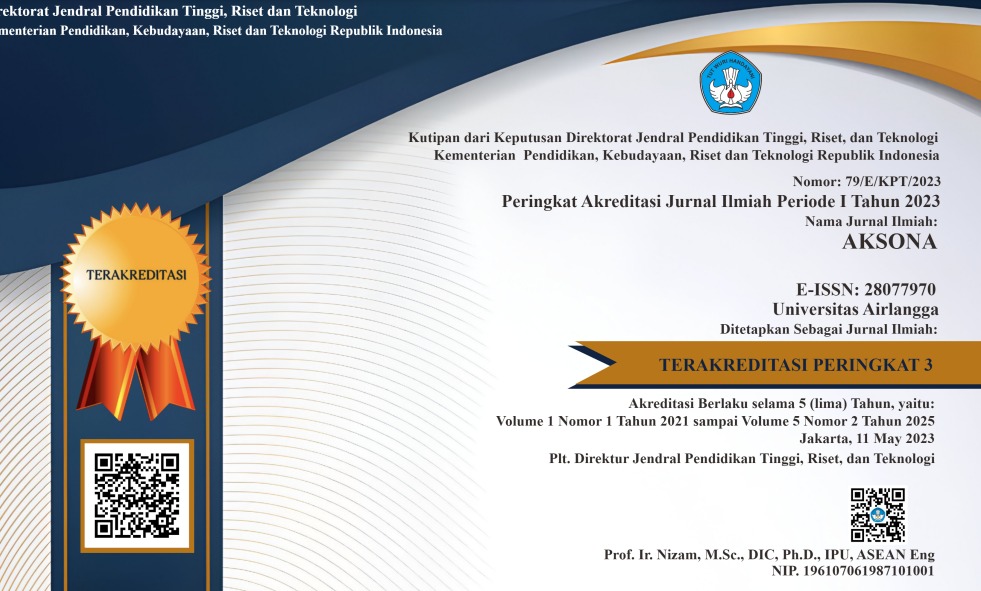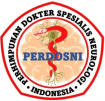Comparison of Recurrent Stroke in Patients with First Stroke Ischemic and Hemorrhagic in Soetomo General Academic Hospital Surabaya
Downloads
Highlight:
- The incidence of recurrent stroke in patients with the first stroke of ischemic type was 2.5-fold higher than that of hemorrhagic type, with the majority of recurrent strokes being the same type as the first stroke.
- Hypertension is the most common modifiable stroke risk factor in both stroke types, and in 5% of cases, secondary prevention is still not optimal.
- The average length of hospital stay for patients with the first stroke of hemorrhagic type was 3 days longer, along with a higher average NIHSS score on presentation than patients with ischemic stroke.
ABSTRACT
Introduction: Stroke is the leading cause of mortality and disability in Indonesia, as well as being the major cause of death and disability-adjusted life years (DALY) lost worldwide. Recurrent stroke is one of the most common complications of stroke after discharge, despite being highly preventable. Objective: This study aimed to compare the differences in recurrent stroke profiles between patients with first stroke ischemic and hemorrhagic strokes. Methods: The study was done by collecting secondary data from medical records and the stroke registry at Dr. Seotomo General Academic Hospital over a period of six months (January–July 2020). Result: This study examined 36 samples that met the inclusion criteria. The results revealed that patients who experienced their first stroke of the ischemic type had a 2.5-fold higher incidence of recurrent stroke than those who suffered a hemorrhagic type. Except for one case, the majority of patients had the same type of stroke as the first. The most frequent modifiable risk factors seen in these two types of strokes are hypertension and physical inactivity. It was found that there were still 5% of the risk factors for which secondary prevention had not been carried out optimally with antidyslipidemic, antidiabetic, or antihypertensive drugs. The most common acute treatment for ischemic stroke is antiplatelet therapy, either single or dual therapy. Up to 90% of hemorrhagic strokes were treated conservatively, and in one patient, extraventricular drainage was performed. Conclusion: There were more stroke patients with a first stroke of hemorrhagic type that presented with NIHSS scores in the severe to very severe range, and the average length of hospitalization in this group was longer.
Murray CJL, Vos T, Lozano R, et al. Disability-adjusted life years (DALYs) for 291 diseases and injuries in 21 regions, 1990–2010: a systematic analysis for the Global Burden of Disease Study 2010. The lancet. 2012;380(9859):2197-2223.
WHO. Projections of mortality and causes of death, 2015 and 2030. [Cited 2021 Feb 21] Available at: https://knowledge4policy.ec.europa.eu/visualisation/top-causes-death-global-projections-mortality-causes-death-2015-2030_en
Ministry of Health, Republic of Indonesia. Profil Kesehatan Indonesia 2018. Jakarta: Badan Penelitian dan Pengembangan Kesehatan. Published online 2018. [Accessed 2021 Feb 23] Available from: https://repository.badankebijakan.kemkes.go.id/id/eprint/3514/
WHO. Global health estimates: Leading causes of DALYs. Published online 2020. Available from: https://www.who.int/data/gho/data/themes/mortality-and-global-health-estimates/global-health-estimates-leading-causes-of-dalys.
Sacco RL, Kasner SE, Broderick JP, et al. An updated definition of stroke for the 21st century: a statement for healthcare professionals from the American Heart Association/American Stroke Association. Stroke. 2013;44(7):2064-2089.
Amila A, Sinaga J, Sembiring E. Pencegahan Stroke Berulang Melalui Pemberdayaan Keluarga dan Modifikasi Gaya Hidup. Jurnal Abdimas: LP2M UNS. Published online 2018. [Cited 2021 Mar 3] Available from: https://journal.unnes.ac.id/nju/index.php/abdimas/article/view/15808
Misbach J, Lamsudin R, Allah A, et al. Guideline Stroke Pokdi Stroke Perhimpunan Dokter Spesialis Saraf Indonesia (PERDOSSI). Published online 2011. [Cited 2021 Mar 3] Available at: https://www.academia.edu/31321416/GUIDELINE_STROKE_TAHUN_2011_POKDI_STROKE_PERHIMPUNAN_DOKTER_SPESIALIS_SARAF_INDONESIA_PERDOSSI_BAGIAN_ILMU_PENYAKIT_SARAF_RSUD_ARIFIN_ACHMAD_PEKANBARU
Soertidewi L, Misbach J. Epidemiologi Stroke. Universitas Indonesia; 2007.
Avan A, Digaleh H, Di Napoli M, et al. Socioeconomic status and stroke incidence, prevalence, mortality, and worldwide burden: an ecological analysis from the Global Burden of Disease Study 2017. BMC Med. 2019;17(1):1-30.
Brust JC. Current Diagnosis & Treatment Neurology. McGraw Hill Professional; 2018.
Siswanto Y. Beberapa Faktor Risiko Yang Mempengaruhi Kejadian Stroke Berulang (Studi Kasus Di Rs Dr. Kariadi Semarang). Jurnal Epidemiologi. Published online 2005.
Guzik A, Bushnell C. Stroke epidemiology and risk factor management. CONTINUUM: Lifelong Learning in Neurology. 2017;23(1):15-39.
Powers WJ, Rabinstein AA, Ackerson T, et al. Guidelines for the early management of patients with acute ischemic stroke: 2019 update to the 2018 guidelines for the early management of acute ischemic stroke: a guideline for healthcare professionals from the American Heart Association/American Stroke Association. Stroke. Published online 2019.
Krishnamurthi R V, Feigin VL, Forouzanfar MH, et al. Global and regional burden of first-ever ischaemic and haemorrhagic stroke during 1990–2010: findings from the Global Burden of Disease Study 2010. Lancet Glob Health. 2013;1(5):e259-e281.
Leoo T, Lindgren A, Petersson J, Von Arbin M. Risk factors and treatment at recurrent stroke onset: results from the Recurrent Stroke Quality and Epidemiology (RESQUE) Study. Cerebrovascular Diseases. 2008;25(3):254-260.
Bailey RD, Hart RG, Benavente O, Pearce LA. Recurrent brain hemorrhage is more frequent than ischemic stroke after intracranial hemorrhage. Neurology. 2001;56(6):773-777.
Shah RS, Cole JW. Smoking and stroke: the more you smoke the more you stroke. Expert Rev Cardiovasc Ther. 2010;8(7):917-932.
Kleindorfer DO, Towfighi A, Chaturvedi S, et al. 2021 guideline for the prevention of stroke in patients with stroke and transient ischemic attack: a guideline from the American Heart Association/American Stroke Association. Stroke. 2021;52(7):e364-e467.
Hemphill III JC, Greenberg SM, Anderson CS, et al. Guidelines for the management of spontaneous intracerebral hemorrhage: a guideline for healthcare professionals from the American Heart Association/American Stroke Association. Stroke. 2015;46(7):2032-2060.
Gaberel T, Magheru C, Parienti JJ, Huttner HB, Vivien D, Emery E. Intraventricular fibrinolysis versus external ventricular drainage alone in intraventricular hemorrhage: a meta-analysis. Stroke. 2011;42(10):2776-2781.
Kumar S. Hypertension and hemorrhagic stroke. Hypertens J. 2017;3(2):89-93.
Kholis AH. Pembentukan Ems (Emergency Medical System) Sederhana Melalui 3d (Detection, Dispatch, Delivery) Dalam Meningkatkan Manajemen Pra-Hospital Pasien Stroke Di Desa Grogol Wilayah Kerja Puskesmas Cukir Kabupaten Jombang: Establishment Of Simple EMS (Emergency Medical System) Through 3D (Detection, Dispatch, Delivery) In Improving Stroke Patient Pra-Hospital Management In Work Region Grogol Village Puskesmas Cukir Jombang. Jurnal Pengabdian Masyarakat Kesehatan. 2019;5(1):13-18.
Rahmawati I, Palupi LM. DETEKSI DINI GEJALA STROKE SEBAGAI BAGIAN DARI PROGRAM BINA KELUARGA LANSIA DI KABUPATEN MALANG. LINK. 2020;16(1):54-58.
Sodikin S, Asiandi A, Supriyadi S. PELATIHAN DETEKSI DINI STROKE DENGAN METODE SEGERA KE RS BAGI WARGA MUHAMMADIYAH. In: Prosiding Seminar Nasional LPPM UMP. Vol 2. ; 2021:122-129.
Kholis AH. SOSIALISASI DETEKSI DINI FAST STROKE DALAM MENINGKATKAN MANAJAMEN PRAHOSPITAL PASIEN STROKE. Jurnal Pengabdian Masyarakat Kesehatan. 2016;2(2):17-20.
Chang KC, Tseng MC, Weng HH, Lin YH, Liou CW, Tan TY. Prediction of length of stay of first-ever ischemic stroke. Stroke. 2002;33(11):2670-2674.
Nastaghfiruka PA, Ardhi MS, Setyowatie S, Nastaghfiruka PA, Campus A, Moestopo JMPD. Defining The Correlation between Blood Pressure and Improvement of Clinical Severity Using the National Institutes of Health Stroke Scale (NIHSS) in Acute Ischemic Stroke Patients of Dr. Soetomo Hospital Surabaya.
Putra MPJ, Sani AF, Lestari P, Ardhi MS. Bleeding Volume, Blood Pressure, and Consciousness Level in Association with the Mortality Rate among Patients with Intracerebral Hemorrhage at Dr. Soetomo General Hospital, Surabaya. Althea Medical Journal. 2020;7(2):51-54.
Copyright (c) 2024 Marselia Febriyanti Sihotang, Mohammad Saiful Ardhi, Muhammad Arifin Parenrengi

This work is licensed under a Creative Commons Attribution-ShareAlike 4.0 International License.





















